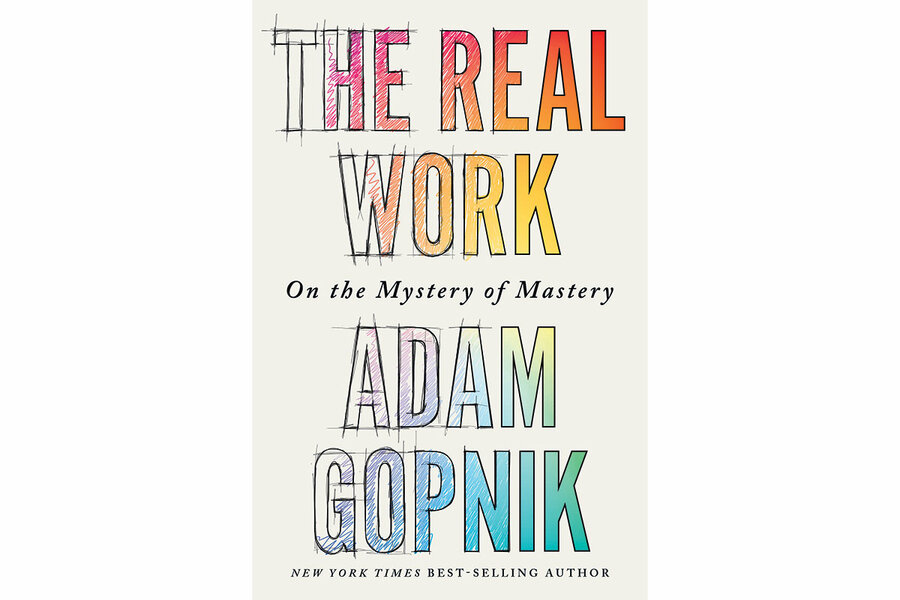How virtuosos are made: Behind the mystery of mastery
Loading...
Malcolm Gladwell’s “Outliers” popularized the idea that it takes 10,000 hours of practice to achieve mastery in any skill. Adam Gopnik’s captivating book “The Real Work” honors perseverance, but it rejects such easy formulations. The New Yorker critic puts himself in the hands of experts in a range of fields, including drawing, boxing, baking, and driving, in an effort to understand how virtuosos attain their proficiency.
Gopnik, who writes art criticism while acutely aware that he lacks artistic talent, apprentices himself to a classical realist painter. After his first lesson, Gopnik writes, “I was filled with feelings of helplessness and stupidity and impotence that I had not experienced since elementary school.”
Why We Wrote This
A story focused onHow do you get good – really good – at something? The New Yorker’s Adam Gopnik looks at the importance of small steps – and a willingness to look foolish.
That response will likely resonate: As we age, wishing to avoid those unpleasant sensations, we increasingly stick with what we know how to do well. As he makes progress, he learns a simple but profound lesson, that accomplishment is “a composite of small steps.”
While Gopnik admires the masters around him, he makes clear we need not strive for perfection in all we do. He writes: “I take as much pleasure from playing ‘Lullaby of Birdland’ badly as George Shearing did in writing it well.” Mastery has its place, but so too does joy.
Malcolm Gladwell’s 2008 book “Outliers” popularized the idea that it takes 10,000 hours of practice to achieve mastery in any skill. Adam Gopnik’s captivating book “The Real Work” honors perseverance, but it rejects such easy formulations, as its subtitle, “On the Mystery of Mastery,” suggests. In a collection of essays, the New Yorker critic puts himself in the hands of experts in a range of fields, including drawing, boxing, baking, and even driving, in an effort to understand how virtuosos attain their proficiency.
The title borrows a phrase used by magicians: When they refer to “the real work,” Gopnik writes, they mean “the accumulated craft, savvy, and technical mastery that makes a great magic trick great.” Magic, of course, is an art whose mysteries are meant to remain concealed. In the book’s rich chapter on the subject, Gopnik points out that because magicians’ techniques are intentionally obscured from spectators, it is, paradoxically, more difficult to discern their subtle mastery.
The same cannot be said for drawing. The skill involved in deploying a pencil to accurately represent an object invites appreciation from viewers. Gopnik, who writes art criticism while acutely aware that he lacks artistic talent, apprentices himself to Jacob Collins, a classical realist painter who runs a New York City atelier. The author’s initial sketches are discouraging, with his attempt to draw an eye, he laments, resembling “a football inside a pair of parentheses.” After his first lesson, he writes, “I was filled with feelings of helplessness and stupidity and impotence that I had not experienced since elementary school.”
Why We Wrote This
A story focused onHow do you get good – really good – at something? The New Yorker’s Adam Gopnik looks at the importance of small steps – and a willingness to look foolish.
That response will likely resonate with those who’ve taken on the challenge of trying something new. Some, like Gopnik, will have to reach back to childhood for memories of incompetence. As we age, wishing to avoid those unpleasant sensations, we increasingly stick with what we know how to do well, the author observes. Despite his discomfort, however, he continues with his drawing classes. As he makes progress, he learns a simple but profound lesson that is threaded throughout the book, that accomplishment is “a composite of small steps.”
There’s comfort in that notion, as it makes the formidable task of acquiring a new skill more manageable. The book offers additional comforts as well. One is that mastery is not only the province of recognized experts; rather, it surrounds us in our everyday lives. Gopnik, a resident of New York City for decades, didn’t learn to drive until late middle age. One of the book’s chapters is a fond portrayal of his enthusiastic driving instructor, Arturo Leon, who in their first moments together has his inexperienced, panicked student drive directly into rush-hour traffic. Leon turns out to be a deft teacher, and by chapter’s end, Gopnik has his license in hand.
Similarly, the master baker Gopnik asks to instruct him is not a celebrity chef but his own mother, a retired college professor whose zeal for baking seems superhuman. “As a kid, I never left for school without being equipped with croissants or pain au chocolat or cinnamon babka or sticky buns, often in combination,” he recalls of his childhood in Montreal. Years later, during an intensive weekend of mixing and kneading and rolling, she shares her knowledge and techniques with him.
The publication in which Gopnik’s work usually appears is known for its impeccable copy editing, which is perhaps another example of the hidden mastery all around us. That thought was prompted by my stumbling over several typos in the book, with the misspelling of Gatsby’s Tom Buchanan being the most egregious.
While Gopnik admires the masters around him, he makes clear that we need not strive for perfection in all that we do. “We can do some things badly and still feel good about having done them, and some things well and still feel badly about not doing them better,” he observes. Offering a personal example, he writes, “I take as much pleasure from playing ‘Lullaby of Birdland’ badly as George Shearing did in writing it well.” Mastery has its place, but so too does joy. Perhaps the most fortunate among us are those for whom the two go hand in hand.







